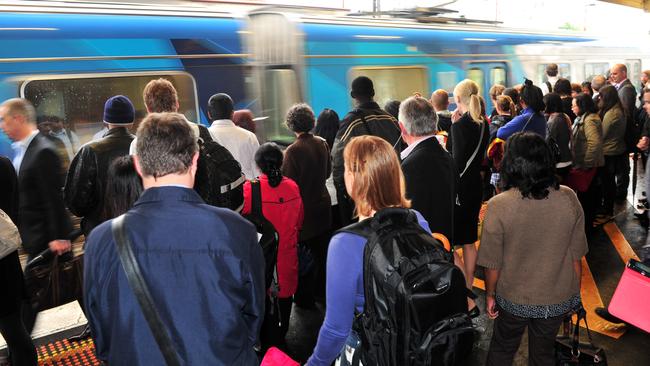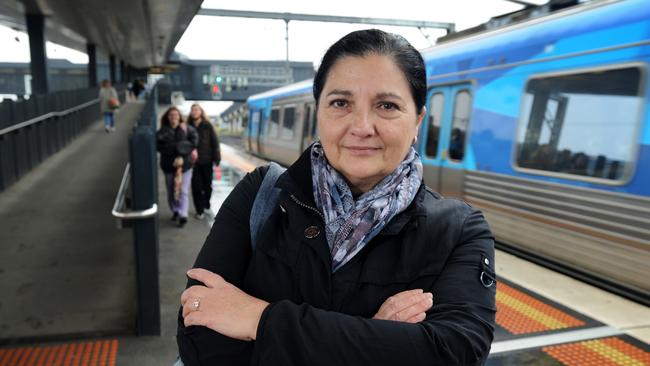Massive surge in Metro’s train passengers driving Melbourne’s peak hour crush
For many Melburnians who catch the train during peak hour, it won’t come as a surprise that the city’s train network is struggling to handle the surge of millions of extra passengers. These are the worst hit lines.

VIC News
Don't miss out on the headlines from VIC News. Followed categories will be added to My News.
Commuters are being squeezed into carriages like sardines as Melbourne’s train network struggles to handle the pressure of millions of extra passenger journeys.
There are now 14.7 million more annual trips recorded across the city than there were five years ago, new Department of Transport figures show.
Surging population growth has also heaped immense pressure on stations in the outer suburbs.
Patronage has surged by five times what it was in 2013-14 at Officer, in the southeast, and doubled at Diggers Rest, in the northwest, over the same period.
The influx is creating a domino effect down the line as peak-hour commuters struggle to cram into full trains approaching the city.
Public Transport Minister Melissa Horne said the state government was working with Metro Trains to reduce crowding.

“Since 2015, we’ve added more than 530 new weekly train services, with close to 100 of those in peak hour, to reduce crowding and improve services for locals,” she said.
It’s understood a major timetable update was due to be rolled out this year but is now expected in 2020, with no additional services added to the schedule in 2019.
The last major change came in August 2018 when the network was extended to Mernda in the city’s northeast.
Melbourne’s $11 billion Metro Tunnel will take pressure off some of the city’s busiest lines but the mammoth project is not due to be finished until 2025.
Transport Infrastructure Minister Jacinta Allan said the project would make room for an extra 500,000 people across the metropolitan network.

“We’re also working on the Western Rail Plan, which will give people in the growing western suburbs access to Metro services for the first time,” she said.
Some of the biggest passenger increases were recorded between Kensington and Craigieburn and on corridors running through Footscray, Sydenham and Caulfield.
Public Transport Users Association spokesman Daniel Bowen said governments needed to invest in extra services to make sure timetables kept up with growth.
MORE NEWS:
PREMIER’S PLEA FOR A FIX TO DODGY CLADDING IMPORT CRISIS
AMBOS SEEING RED OVER ANDREWS PAY DISPUTE
HERO DIES SAVING GRANDDAUGHTER FROM BURNING HOUSE
“While some lines can’t take many more peak-hour services until the Metro Tunnel opens, authorities must make the most of existing track and fleet capacity to cut crowding,” he said.
“Cutting the current long waiting times of 20, 30 or even 40 minutes would bring huge benefits for our growing city.”
Maria Mikovic catches the Sunbury line to work every day, but finds the carriages are often packed long before West Footscray.
“It’s chock-a-block … I can never get a seat, I always have to stand,” she said.
“Sometimes I borrow my daughter’s car before work, just so I don’t have to catch the train.”
TRAIN STATIONS WITH THE BIGGEST PASSENGER INCREASES
Officer
2013-14 — 19,000
2018-19 — 123,000
Up 537 per cent
Diggers Rest
2013-14 — 66,000
2018-19 — 221,000
Up 234 per cent
Jacana
2013-14 — 80,000
2018-19 — 227,000
Up 183 per cent
Williams Landing
2013-14 — 809,000
2018-19 — 1.75 million
Up 17 per cent
Ruthven
2013-14 — 205,000
2018-19 — 409,000
Up 99 per cent
Gowrie
2013-14 — 168,000
2018-19 — 321,000
Up 91 per cent
Patterson
2013-14 — 211,000
2018-19 — 354,000
Up 68 per cent
West Footscray
2013-14 — 448,000
2018-19 — 733,000
Up 64 per cent
Cardinia Road
2013-14 — 247,000
2018-19 — 382,000
Up 55 per cent
Jordanville
2013-14 — 325,000
2018-19 — 499,000
Up 54 per cent
TRAIN TRIPS ACROSS MELBOURNE
2013-14 — 214.9 million
2018-19 — 229.6 million
An increase of 14.7 million
BUSIEST STATION
Flinders Street — 28 million annual passengers
BIGGEST INCREASE
Southern Cross — 2.46 million more passengers than five years ago
78.1 million passengers travel through City Loop each year


